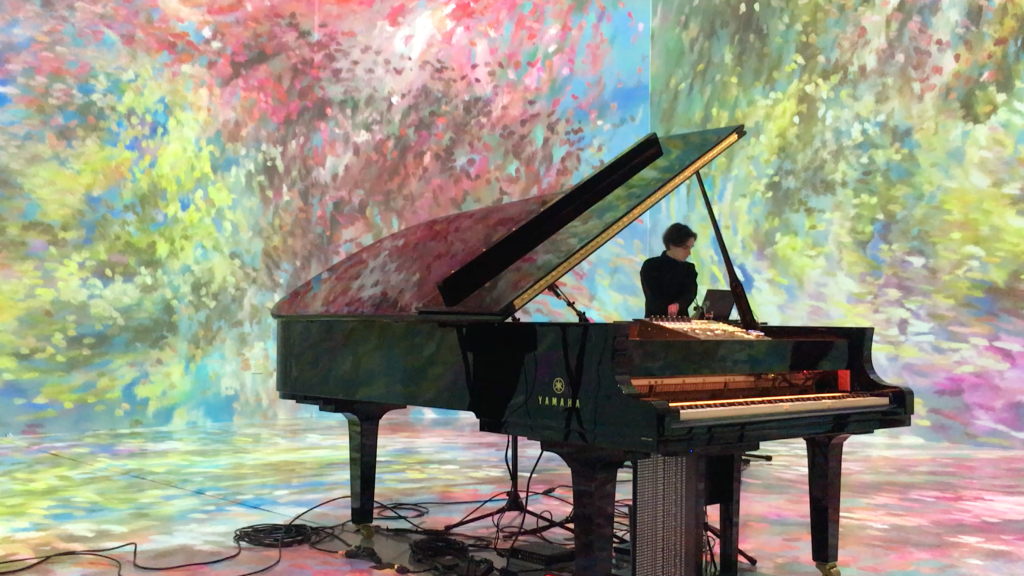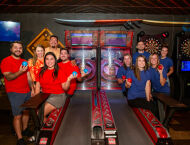Culture
 "Transient: Impermanent Painting." Photo courtesy of ARTECHOUSE.
"Transient: Impermanent Painting." Photo courtesy of ARTECHOUSE.
In Artist Quayola’s “Transient,” The Algorithm Decides
January 19, 2022 @ 2:00pm
We often consider technology a catalyst for performance art, rather than an actor that facilitates expression. With humans standing tête-à-tête with technology, embracing an increasingly emotive relationship between the physical and the digital has led artists to reach unparalleled levels of expression.
In ARTECHOUSE’s new exhibit “Transient: Impermanent Painting,” Italian multimedia artist Quayola projects hyperrealistic pictorials of paint strokes against the sound of a coded, computerized Yamaha piano. As each note follows, and each color morphs into the next, the connection between Quayola’s technologies creates a sensory fusion between sight and sound.
The colors of the presentation take on a mélange of soft pastel hues that are ‘painted’ onto the wall with a variety of strokes — think of a mix between pointillist precision and wide impressionist blends that seemingly correlate with the swiftness of a staccato and the longevity of an extended note.
“Transient’s” intimate opening was marked by an exclusive live performance by Quayola and digital artist SETA. What’s special about this type of live performance, and the irony of impermanence in a digital world, is that the artists’ live concert is remembered and learned by the computer, which inherently codes both the music and the visuals. Therefore, even after the artists finish their live performance, if told to, the computer could replicate the music to attain the same visual outcome again and again.
In a discussion after the performance, Quayola shed light on his experience co-creating a sonic-visual experience with technology, and how this connection allowed him to align with new aesthetics. Technology is less of a menial artistic aid, but rather a tool used to explore levels of expression that have not yet been reached.
As Quayola explained, “This work is really about the relationship between us and machines — it’s how machines can of course allow us to do new things, and how machines allow us to change the way we perceive the world.”
At times, the music resembles the lightheartedness of Saint-Saëns’ “Carnival of the Animals,” and the depth of a Chopin etude. But in reality, it’s neither. Quayola has engineered the brain of the piano to generate music by itself, and he simply guides the process. Thus, rather than replicate the musical works of the artists of the past, Quayola pays homage, as he puts it, to “the symbol of the heritage of musical instruments, although used in a very unconventional way.”
Ultimately, Quayola said the decision to compose the aural element of “Transient” using coded language is a figment of “using technology as a way to discover new things, but at the same time, looking at the past.”
Surprisingly, Quayola admits the musical code that selects which notes produce which color is far from synesthetic. Synesthesia implies intentionality — and while a computer program does place learned intention towards note selection, there is a degree of sensory randomness that Quayola is more interested in evoking.
Complementary to “Transient’s” main spectacle, the side galleries off of the primary exhibit hall offer glimpses into Quayola’s process for building the piece. Interactive charts which reveal how the notes of the piano are coded into a computer processor provide a greater understanding of how computer languages can be used in artistic contexts.
Moreover, while artists like Quayola have experimented with encoded visuals for upwards of 10 years, a growing fascination with internet culture, compounded by possibilities to create for the metaverse, has certainly amplified mainstream interest in spaces where hyperrealist technology is created.
“Transient” reveals the inevitable assemblage that results in the melding of the human sphere with the technological landscape. When the physical and the digital collide, they design an artistic experience that neither could create without the other. This is the exact specialty demonstrated in Quayola’s work, and one which creators will continue to experiment with as art and artificial intelligence merge.
ARTECHOUSE DC: 1238 Maryland Ave. SW, DC; artechouse.com // @artechouse







